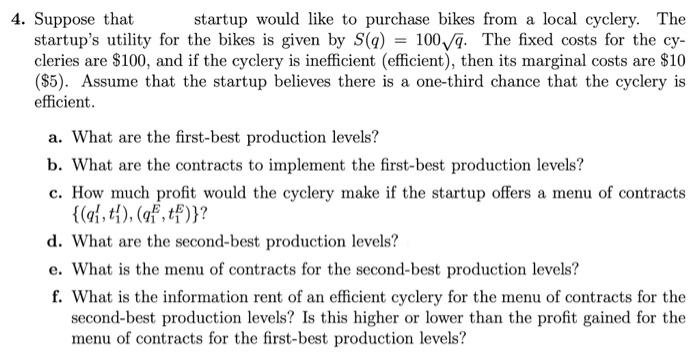Answered step by step
Verified Expert Solution
Question
1 Approved Answer
please help with part a-f more background info: 4. Suppose that startup would like to purchase bikes from a local cyclery. The startup's utility for
please help with part a-f 

4. Suppose that startup would like to purchase bikes from a local cyclery. The startup's utility for the bikes is given by S(q) = 100/9. The fixed costs for the cy- cleries are $100, and if the cyclery is inefficient (efficient), then its marginal costs are $10 ($5). Assume that the startup believes there is a one-third chance that the cyclery is efficient. a. What are the first-best production levels? b. What are the contracts to implement the first-best production levels? c. How much profit would the cyclery make if the startup offers a menu of contracts {(91,4), (9Ft)}? d. What are the second-best production levels? e. What is the menu of contracts for the second-best production levels? f. What is the information rent of an efficient cyclery for the menu of contracts for the second-best production levels? Is this higher or lower than the profit gained for the menu of contracts for the first-best production levels? Consider a bike-sharing company locally operating in San Francisco. In an attempt to overcome losses from theft, the management considers to invest on an innovation adopted by bike sharing programs. Prior to use of the innovation, the researchers see that if the current theft rate is at least 5 per day, then the innovation will yield a net savings of $43,000 to the company over the span of one year. On the other hand, if the current theft rate is less than 2 per day, then the company does not incur any savings from this investment, which will cost $64,000 to the company. Suppose that the analysts decide to perform a minimax hypothesis testing approach to learn the effectiveness of the innovation. The recorded number of thefts over the last 9 days are: 6, 5, 3, 2, 2, 3, 2, 4, 3. 4. Suppose that startup would like to purchase bikes from a local cyclery. The startup's utility for the bikes is given by S(q) = 100/9. The fixed costs for the cy- cleries are $100, and if the cyclery is inefficient (efficient), then its marginal costs are $10 ($5). Assume that the startup believes there is a one-third chance that the cyclery is efficient. a. What are the first-best production levels? b. What are the contracts to implement the first-best production levels? c. How much profit would the cyclery make if the startup offers a menu of contracts {(91,4), (9Ft)}? d. What are the second-best production levels? e. What is the menu of contracts for the second-best production levels? f. What is the information rent of an efficient cyclery for the menu of contracts for the second-best production levels? Is this higher or lower than the profit gained for the menu of contracts for the first-best production levels? Consider a bike-sharing company locally operating in San Francisco. In an attempt to overcome losses from theft, the management considers to invest on an innovation adopted by bike sharing programs. Prior to use of the innovation, the researchers see that if the current theft rate is at least 5 per day, then the innovation will yield a net savings of $43,000 to the company over the span of one year. On the other hand, if the current theft rate is less than 2 per day, then the company does not incur any savings from this investment, which will cost $64,000 to the company. Suppose that the analysts decide to perform a minimax hypothesis testing approach to learn the effectiveness of the innovation. The recorded number of thefts over the last 9 days are: 6, 5, 3, 2, 2, 3, 2, 4, 3 
more background info:

Step by Step Solution
There are 3 Steps involved in it
Step: 1

Get Instant Access to Expert-Tailored Solutions
See step-by-step solutions with expert insights and AI powered tools for academic success
Step: 2

Step: 3

Ace Your Homework with AI
Get the answers you need in no time with our AI-driven, step-by-step assistance
Get Started


